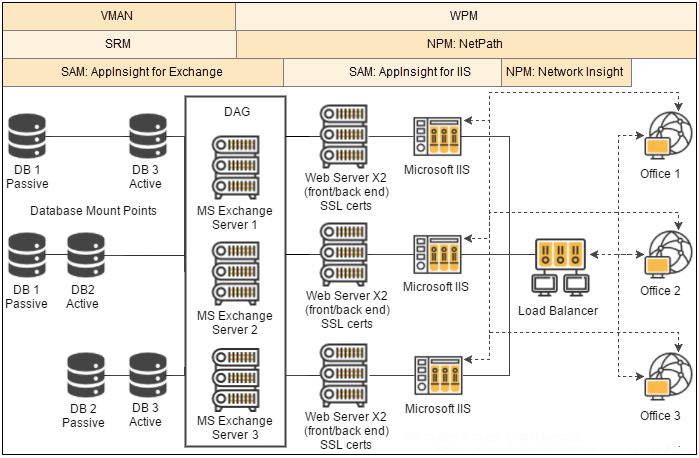SolarWinds approach to comprehensive Exchange monitoring
This SolarWinds Platform topic applies only to the following products:
Hybrid Cloud Observability Essentials — Hybrid Cloud Observability Advanced
NPM — SAM — SRM — VMAN — WPM
To comprehensively monitor your Exchange environment, you must monitor the health of the Exchange application and all associated elements (IIS, SQL Server, etc.), the health of the hardware that hosts the software (Exchange servers and load balancers), the performance of transactions from end-users to the Exchange environment, and the health of the storage devices where Exchange data is stored.
SolarWinds solutions
SolarWinds provides five modules that you can use to monitor your Microsoft Exchange environment. Depending on your organization's needs, you can deploy all modules or only a subset.
| This module... | Monitors this aspect of your Exchange environment... |
|---|---|
| Server & Application Monitor (SAM) |
SAM is a crucial part of the Exchange monitoring solution. SAM monitors the back end of your Exchange environment, consisting of servers and database availability groups (DAGs). During discovery, the SolarWinds Platform identifies each server and automatically applies either an AppInsight for Exchange template or an AppInsight for IIS template.
SAM also displays application-related data (including applications, servers, hosts, and volumes) in the AppStack. The AppStack is a visual mapping that provides health and status information to help you troubleshoot performance and availability issues. |
| Virtualization Manager (VMAN) | If your Exchange servers are running virtually, VMAN provides in-depth information about your virtual environment and adds this data to the AppStack. VMAN also correlates virtual disks to the physical disks in the back-end storage layer so that you can identify and correct storage problems. Use VMAN to troubleshoot disk usage issues in a virtual environment, such as storage I/O problems caused by a "noisy neighbor" that is consuming I/O resources needed by Exchange. |
| SRM monitors the storage arrays used to store Exchange data. SRM correlates disks to storage devices on the network, and provides data about the capacity and performance of your storage devices. With SRM, information about storage devices (including array, volumes, and LUNs) is shown in the AppStack. | |
| Network Performance Monitor (NPM) |
|
| Web Performance Monitor (WPM) |
WPM runs test transactions from office locations to the load balancer and Exchange servers. WPM provides information about what users experience when they access Microsoft Outlook, and alerts you if Outlook takes significantly longer than usual to load or if users cannot access the site. NetPath tells you if a location is accessible and if there are lags along the path. WPM mimics user actions by playing back recorded transactions, which provides an in-depth view into the performance of connections, servers, authentication, and more. For example, WPM can alert you if a single server in your CAS array is returning pages more slowly than other pages in the same array. |
The following graphic shows how these modules combine to monitor the entire Exchange architecture.
Exchange deployments vary. This example shows an Exchange 2016 environment. The Exchange servers are within a DAG and are accessed through a load balancer. The instructions in this guide are tailored for a similar configuration.

Next steps
To configure SolarWinds modules to monitor Exchange, complete the following tasks:
- Discover your Exchange environment
- Configure one or more of the following modules:
- Set up alerts to monitor your Exchange environment
- Filter the AppStack to show only your Exchange environment
